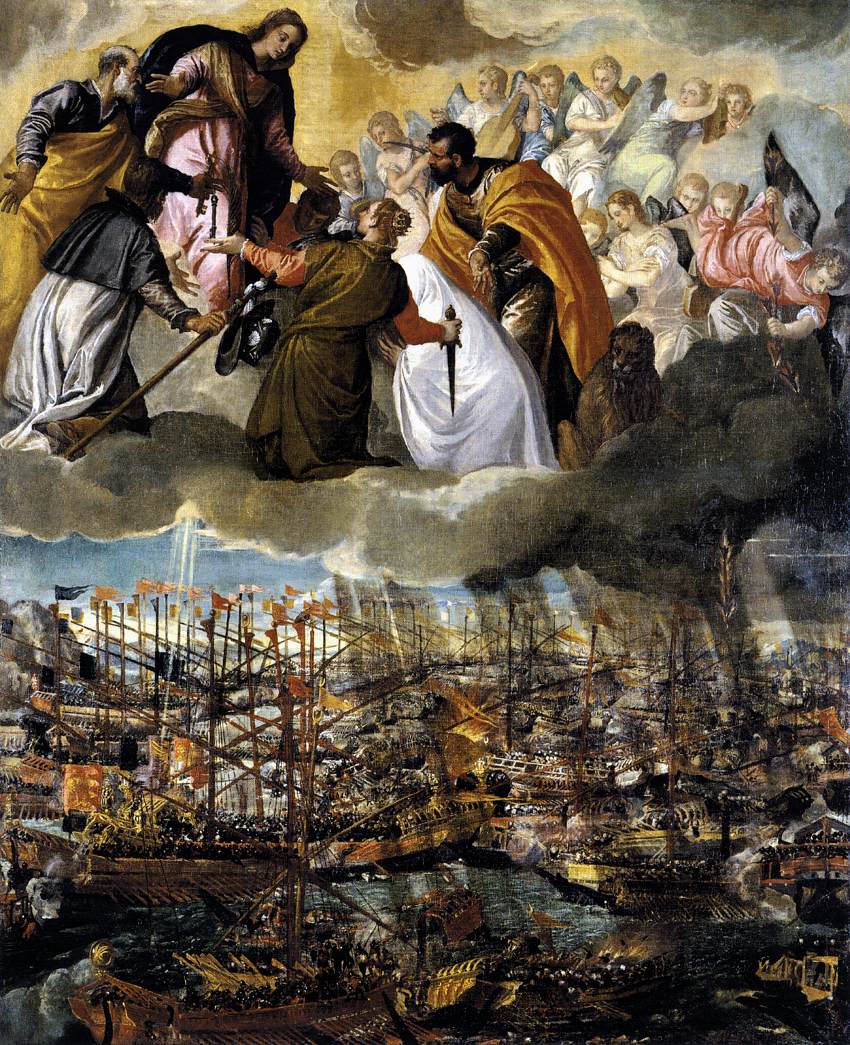
Ask most people about the Battle of Lepanto today and you will be met with wither an uneasy smile or ignorance. For most of modern, secular Europe, Lepanto was a bloodthirsty massacre inspired by religious bigotry, a blight upon history whose memory must be forgotten, suppressed, and buried. Yet five hundred and thirty seven years ago, that fateful battle forever fixed the boundaries of the Mediterranean.
Few will probably know that Lepanto was the deciding factor that put a stop to Ottoman expansionism; a loss for the Christian side could have very easily meant the fall of Europe. On one side we have the Christian Holy League, under the aegis of the Spanish Hapsburgs, and sailing with the blessing of the Pope himself; on the other, the Ottoman champions, under the leadership of Ali Pasha. But at stake was more than just military power or economic dominance; indeed, one could probably say that Lepanto was as much a battle for the survival of Europe.
No easy task was this-- the mid 1500's was a time of upheaval in Europe. The convocation of the Holy League itself was fraught by mutual suspicion on the parts of those involved. The neutral Venetians were seen as self-serving and treacherous; Spain was seen as too prudent; and everyone secretly balked at the pope's wish to reclaim the Holy Land. Jealousy and division, and not to mention an almost genetically disposed inferiority complex against the Ottomans (conquerors of Byzantium), plagued the Christian side.
Fast forward to 7 October 1571, to one of the bloodiest days in history. In the span of but four hours, 40,000 people darkened the sea with their blood; fire and flame and smoke were everywhere, as the thunderous din of combat blasted ear drums and shook the marrow of men on both sides. However the day would ultimately go to the Christian side, thanks in part to the heavily armed Venetian galleases and the brilliant leadership of Don Juan of Austria. It was nothing short of a miracle-- the Christian Holy League, which up until a few hours before the conflict were arguing amongst themselves, would crush Ottoman power in a victory nothing short of remarkable-- and dangerously close. The leader of the Ottoman fleet, Ali Pasha, resplendent in his brilliant robes, was said to have been felled by an arquebus shot, after which his head had been decapitated by a Spanish soldier and attached to the tip of a spear. It was said that Don Juan was appalled by this barbarous treatment of what he considered a most worthy opponent.
In Europe, a collective sigh of relief was breathed, with the Venetians rejoicing the most. In Rome, it was said that St. Pius V, while in the middle of prayer, was roused by the vision of the enemy kapudan pasha (admiral), Ali Pasha, falling into the sea. It was a sign of victory, and on a most auspicious day, the Feast of Our Lady of the Rosary. Pius made sure to add another gem to the Virgin's crown, naming her Our Lady of Victories for the Christian victory against the Turk. The victory of Lepanto had put a permanent check on the expansionist dreams of the Ottomans; henceforth, the Mediterranean would be in a stalemate. Divided Europe came dangerously close to being subjected to Islamic dominance, with the Mediterranean serving as the bloody theater of history. Malta alone locked Europe from the Ottomans, and from then it would be a short way to Rome, the center of Christendom. Philip turned his attention west, to the New World, while the sultan Selim had Persia on his mind. In time, both empires' power would be checked, Philip in the disastrous loss of his armada, and Selim and his successors by the unblinking thrust of modernity.
Today tensions have generally cooled off. Lepanto has largely been forgotten, the people it saved shrugging off the old myths and legends, its heroes and champions dubbed fanatics. In 1965, the pope returned the captured sail of the main Ottoman warship, the Sultana, to Istanbul; it was a large, green sail, embroidered with the 99 names of Allah repeated close to thirty thousand times. People have forgotten, too, the French knight for whom the capital of Malta, Valleta, was named: Sir Jean Parisot La Valette, who had previously crushed the vastly superior Ottoman forces in the great siege of Malta. He would later go on in history as one of the order's most illustrious grand masters, defending Birgu to the last man with a steely resolve that would infuriate Suleiman the Magnificent himself.
In 1646, Manila was threatened by the sudden appearance of five Dutch warships, bent on conquering the city. The soldiers, Spanish and Filipino alike, vowed to our Lady of the Rosary to feast her with a lavish procession if she gave them this victory. And sure enough, the Dutch invaders were repelled; but the most remarkable thing was that this was to happen for five times. Today, Our Lady of the Rosary is known in the Philippines as Nuestra Senora de La Naval. She is truly the Queen of Victories, savior of Europe and Asia.




















